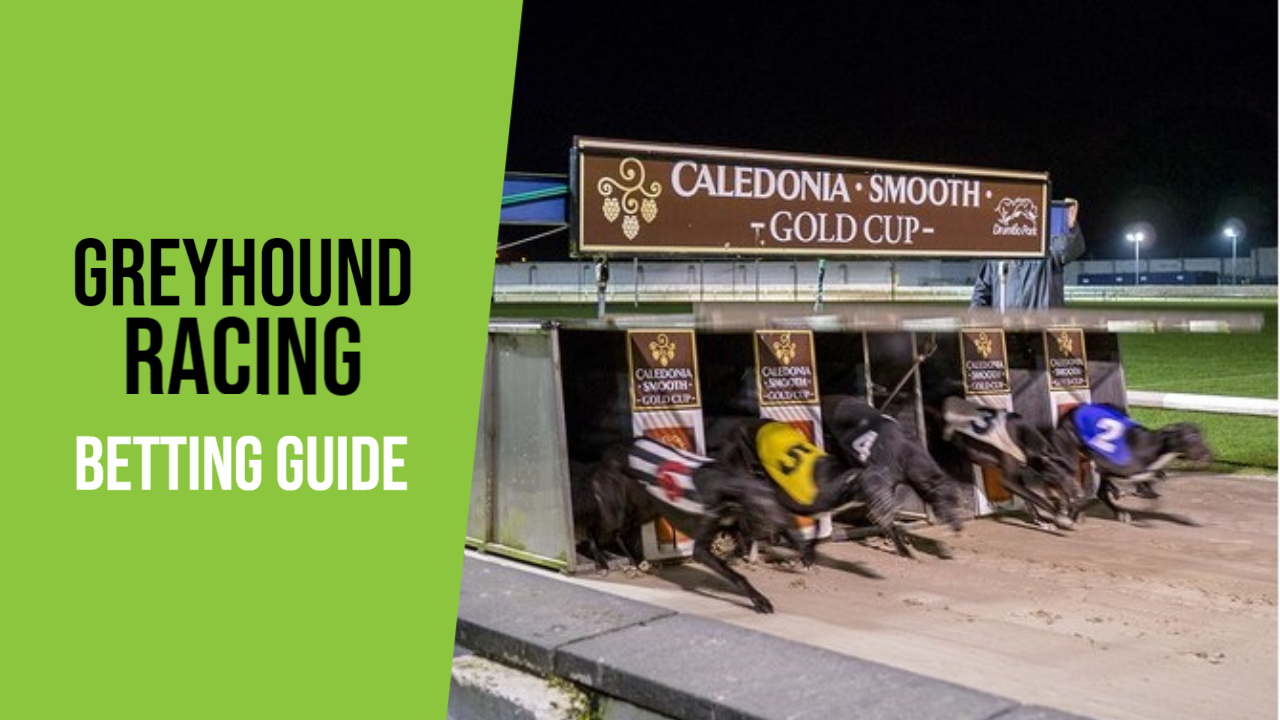
This Greyhound racing guide offers valuable insights into the sport, highlighting key factors that impact race outcomes. Additionally, you’ll find information about the top websites that specialise in greyhound betting. With this knowledge at your disposal, you’ll be equipped to make well-informed decisions when placing your greyhound racing bets.
About Greyhound Betting
Greyhound racing is a spectator sport in many countries and has been a staple of the betting industry for decades. In the sport, greyhounds are enticed by a mechanical lure which runs alongside the track. Greyhound races typically consist of six to eight dogs competing on a track, with distances ranging from 305 to 990 meters.
In addition to traditional greyhound racing, some betting sites also offer virtual greyhound racing, where the races are simulated and bettors can place wagers on the outcome.
It’s important to note that greyhound racing has faced criticism from animal rights organisations due to the treatment of dogs and high injury rates in the sport. In some countries, it has been banned or restricted.
Why Bet On Greyhound Racing?
-
Thrill of the Race
The fast-paced nature of greyhound racing and the unpredictability of the outcome can create excitement and a thrill for spectators and bettors.
-
Strategic Aspect
For those who enjoy analysing and strategising, betting on greyhound races can provide an opportunity to research the dogs' past performance and handicap the races to make informed bets.
-
Social Aspect
Betting on greyhound races can be a social activity, as it can be a fun experience to enjoy with family and friends at the racetrack or to discuss the races and bets with fellow bettors.
-
Sense of Community
Some people may enjoy the sense of community that comes with betting on greyhound races, as it allows them to connect with others who share a similar interest in the dogs.
Popular Greyhound Competitions
Some of the most popular greyhound racing competitions include:
- The English Greyhound Derby: This is one of the oldest and most prestigious greyhound racing events in the world, held annually at Towcester racecourse in England.
- The Irish Greyhound Derby: This is one of the largest greyhound racing events in Ireland, held annually at Shelbourne Park in Dublin.
- The National Greyhound Association Meet: This is the largest greyhound racing event in the United States, held annually in Abilene, Kansas.
- The Melbourne Cup: This is a major greyhound racing event in Australia, held annually at Sandown Park in Melbourne.
The sport is enjoyed by fans around the world, and there are many other local and regional events that take place throughout the year.
Best Bookmakers For Greyhound Betting
I recommend the following bookmakers for placing greyhound racing bets:
#ad. 18+, GambleAware.org, T&Cs Apply
#ad. 18+, GambleAware.org, T&Cs Apply
#ad. 18+, GambleAware.org, T&Cs Apply
#ad. 18+, GambleAware.org, T&Cs Apply
#ad. 18+, GambleAware.org, T&Cs Apply
Considerations For Greyhound Betting
Greyhound racing can be considered a simple sport in terms of its basic rules and objective: greyhounds chase a mechanical lure around a track to see which one can finish first.
However, there are many factors that can influence the outcome of a greyhound race, such as the conditions of the track, the form of the individual dogs, and the tactics employed by the trainers.
Form
The form of an individual greyhound can have a major impact on its performance in a race and, therefore, its chances of winning. Some of the factors that can impact a dog’s form include:
- Age: Younger dogs may be inexperienced and lack the maturity and racecraft of older dogs, while older dogs may be past their prime and no longer able to perform at their best.
- Injuries: Injuries can impact a dog’s form and ability to perform at its best. Even minor injuries can affect a dog’s speed, agility, and stamina.
- Training: The amount and quality of a dog’s training can impact its form and ability to perform in races. Dogs that are well-conditioned and well-prepared are more likely to perform at their best.
- Recent races: The results of a dog’s recent races can provide an indication of its current form. Dogs that have been running well and winning races are likely to be in good form, while dogs that have been struggling and losing races may be out of form.
- Personalities and temperaments: Greyhounds have different personalities and temperaments, and some may be more suited to racing than others. Dogs that are confident, focused, and able to cope with the pressure of racing are more likely to perform at their best.
Track Conditions
The conditions of the greyhound racing track can have a significant impact on the outcome of a race. Some of the key factors that can affect the conditions of the track include:
- Surface: The surface of the track, such as grass or sand, can affect the speed and grip of the greyhounds. Some dogs may perform better on certain surfaces than others, and conditions such as rain or snow can also impact the surface of the track.
- Length: The length of the track can also impact the outcome of a race. Longer tracks may suit dogs with good stamina, while shorter tracks may benefit dogs with a more explosive turn of pace.
- Weather: The weather conditions on race day can greatly impact the conditions of the track. For example, rain can make the track slippery and slow, while hot, humid weather can affect the dogs’ stamina and performance.
- Bend angles: The angles of the bends on the track can also impact the outcome of a race. Some bends may be tighter or wider than others, and this can affect the dogs’ ability to negotiate the turns and maintain their momentum.
- Starting boxes: The starting boxes are an important aspect of the track and can affect the outcome of a race. Some boxes may be considered more advantageous than others, depending on the track and the individual dog’s running style.
It’s important to keep in mind that track conditions can change quickly and unexpectedly, so bettors should always stay up-to-date with the latest information before placing their bets.
Box Draw
The box draw, which refers to the starting position of the greyhounds in the starting boxes, can have a significant impact on the outcome of a race.
Some boxes may be considered more advantageous than others, depending on the track and the individual dog’s running style:
- Inside boxes: Inside boxes, such as boxes 1 and 2, are generally considered the most advantageous, as the dogs have a shorter distance to run to the first bend and can avoid getting caught up in traffic. However, inside boxes can also be more crowded, making it more difficult for the dogs to get a clear run.
- Middle boxes: Middle boxes, such as boxes 3, 4, 5, and 6, can provide the dogs with a balanced mix of advantages and disadvantages. They are not as close to the rail as the inside boxes, but they are also less crowded than the outside boxes.
- Outside boxes: Outside boxes, such as boxes 7 and 8, are generally considered the least advantageous, as the dogs have a longer distance to run to the first bend and are more likely to get caught up in traffic. However, outside boxes can also provide the dogs with a clear run if they get away well.
- Running style: The individual dog’s running style can also impact the significance of the box draw. Some dogs may prefer to run close to the rail, while others may prefer to be wider and avoid traffic.
Tactics
Tactics play an important role in greyhound racing, as trainers and handlers strive to put their dogs in the best position to win races.
Some of the key tactics that can impact the outcome of a race include:
- Early speed: A dog with good early speed can gain an advantage by leading from the start, setting a fast pace, and controlling the race.
- Rail running: A dog that prefers to run close to the rail can benefit from the shortest possible distance around the track and avoid getting caught up in traffic.
- Box to box: A dog with good box to box speed can gain an advantage by making up ground in the early stages of the race and positioning itself for a strong finish.
- Wide running: A dog that prefers to run wide can benefit from a clear run and avoid getting boxed in by other dogs.
- Trapping: Trapping refers to the process of positioning the dogs in the starting boxes, and can have a significant impact on the outcome of a race. By putting their dogs in the right boxes, trainers can give them the best chance of getting away well and avoiding traffic.
Trainer
Handlers and trainers of the dogs play a key role in the outcome of a race. Some of the ways that handlers and trainers can impact a race include:
- Training: A well-trained dog is more likely to perform well in a race, and handlers and trainers play a key role in ensuring that their dogs are in peak physical condition.
- Tactics: As discussed earlier, handlers and trainers can use tactics such as early speed, rail running, box to box speed, and wide running to give their dogs the best chance of winning races.
- Trapping: Handlers and trainers can use their knowledge of the dogs and the track to put their dogs in the best possible boxes and give them the best chance of getting away well.
- Race strategy: Handlers and trainers can also make decisions about when to make a move in a race, how hard to push their dogs, and when to hold back.
- Race planning: Handlers and trainers can also plan out their dogs’ racing schedules, deciding when to enter them in races and when to rest them.
Genetics
Genetics play a significant role in the performance of greyhounds in racing, and are a major factor in determining a dog’s physical characteristics and abilities. Some of the ways that genetics can impact greyhound racing include:
- Speed: Some greyhounds are naturally faster than others, and this can be largely due to their genetics.
- Endurance: A dog’s genetics can also impact its ability to run for longer periods of time and maintain a fast pace.
- Strength: Genetics can also play a role in a dog’s overall strength and ability to withstand the physical demands of racing.
- Conformation: The physical structure of a dog, such as its build, muscle mass, and stride, is largely determined by genetics, and can impact its performance on the track.
- Temperament: A dog’s temperament, including its courage, determination, and level of aggression, can also be influenced by its genetics.
By considering a dog’s genetics when betting on greyhound races, bettors can gain a better understanding of a dog’s likely performance.
Greyhound Betting Markets
Greyhound betting involves betting on the outcome of greyhound races, and there are a variety of betting markets available for bettors to choose from. Some of the most popular greyhound betting markets include:
- Win betting: This is the most straightforward type of greyhound bet, and involves betting on a specific dog to win the race.
- Each-way betting: This type of bet allows bettors to place a win bet and a place bet on the same dog, increasing their chances of a return.
- Forecast betting: This type of bet involves predicting the first and second place finishers in a race in the correct order.
- Tricast betting: This type of bet involves predicting the first, second, and third place finishers in a race in the correct order.
- Accumulator betting: This type of bet involves combining multiple bets into one, with the winnings from each bet being carried over to the next.
- Tote betting: This type of bet is run by the racecourse and involves pooling all of the bets placed on a race and dividing the pool among the winning bettors.
By considering the different types of greyhound betting markets, bettors can choose the market that best suits their betting style. It’s important to remember that different betting markets can offer different odds and returns, so bettors should compare the different options before placing their bets.
Best Sites For Greyhound Stats
The following websites provide free greyhound racing statistics:
You can learn more about these sites here: Best Sites For Free Greyhound Racing Statistics
Greyhound Racing FAQ
Greyhound Racing is a sport in which greyhounds, or dogs bred for speed, chase a lure around a track. The objective is to determine which dog will cross the finish line first. Greyhound Racing is a popular form of gambling, with betting on the outcome of the races a common practice.
Greyhound Racing is scored based on the order in which the dogs cross the finish line. The first-place dog is awarded the highest number of points, while the second and third-place dogs are awarded fewer points. Points are typically used to determine the winner of the race, but they can also be used for other purposes, such as qualifying for a championship event.
The lure, typically made of plastic and attached to a motorized machine, is used to simulate the movement of prey that greyhounds are bred to chase. The dogs chase the lure around the track, with the first dog to cross the finish line being declared the winner of the race.
A trap refers to the starting box assigned to each dog at the beginning of a race. Traps are numbered, with the dogs assigned to each trap randomly. The position of the dog in the trap can have a significant impact on its performance, with some dogs performing better from certain traps.
A greyhound handicap race is a type of race where dogs are assigned different weights based on their past performance. The objective is to level the playing field and create a more competitive race. Handicap races can be more difficult to predict, but they offer the potential for higher payouts.
- Bookmakers With The Fastest Withdrawals | Quick Bookie Payouts - October 23, 2024
- Asian Handicap Vs European Handicap Bets | What’s The Difference? - October 23, 2024
- Bookmakers With The Most Sports & Markets | Bookie Depth - October 22, 2024





